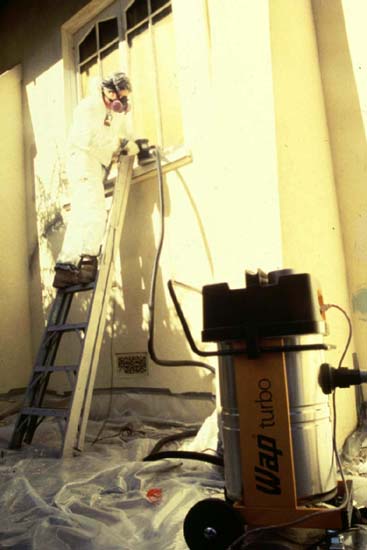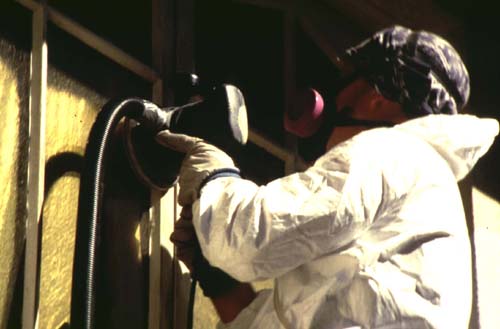Painters Prepping Lead-Paint Surfaces: Researchers find that half-mask respirators do not protect enough for hand sanding or conventional power sanding
Summary Statement
Reports the results of a study of painters exposed to lead paioverexposed to lead and that a half-face respirator often does not provide enough protection.nt while prepping surfaces. Finds that painters are often
2002
Twenty-one painting contractors working in San Francisco joined with the California Department of Health Services to study painters' exposures to lead-paint dust during surface preparation work. The study, in 1994-95, covered work on 12 job sites. The amount of lead in the paint ranged from less than 1% to 42%. The researchers collected two kinds of samples: 25 samples measured workers' total lead exposure during a full shift doing surface preparation, and 58 short-term samples measured the levels of lead that workers were exposed to when using a specific surface preparation method.
Six of 25 full-shift samples showed exposures over the OSHA permissible exposure limit (PEL) of 50 micrograms per cubic meter (µg/m3) (range: 0.8 – 550 µg/m3). This confirmed that painters are often exposed over the OSHA limit if they work unprotected. The short-term sample results showed that painters were most highly exposed when doing dry hand-scraping (average: 71 µg/m3; range: 4 – 230 µg/m3), and particularly when doing dry hand-sanding (average: 420 µg/m3; range: 29 – 1200 µg/m3), and conventional power-sanding (average: 580 µg/m3; range: 65 – 3400 µg/m3). In striking contrast, the lead exposures of painters using vacuum-attached power sanders were 80 to 90% lower than lower than those using conventional hand- or power-sanding (average: 33 µg/m3; range: 4 – 60 µg/m3).
The OSHA Lead in Construction standard requires the use of full-face respirators when using a conventional power sander on lead paint. In practice, though, many painters wear half-mask respirators when power sanding, and this does not protect them enough.
The OSHA standard requires that workers use half-mask respirators (with P-100 filters) when doing dry hand-sanding. However, calculations based on the study results show that, in some cases, using a half-mask respirator is not enough protection.
The study results clearly show that painters should use vacuum-attached power sanders when sanding on surfaces that contain – or may contain – lead-based paint. The OSHA Lead in Construction standard requires that the painter wear a half-mask respirator (with P-100 filters) when using a vacuum-attached power sander. The study results show that the workers who did this were protected enough.
For more information,
see: Scholz, Peter F., Barbara L. Materna, David Harrington,
and Connie Uratsu: Residential and Commercial Painters' Exposure to Lead
during Surface Preparation. AIHA Journal 63:22-28 (2002).
PHOTO CAPTION:
A painter removes lead-based paint using a sander with vacuum attached.
(Photo courtesy of California Department of Health Services.)




